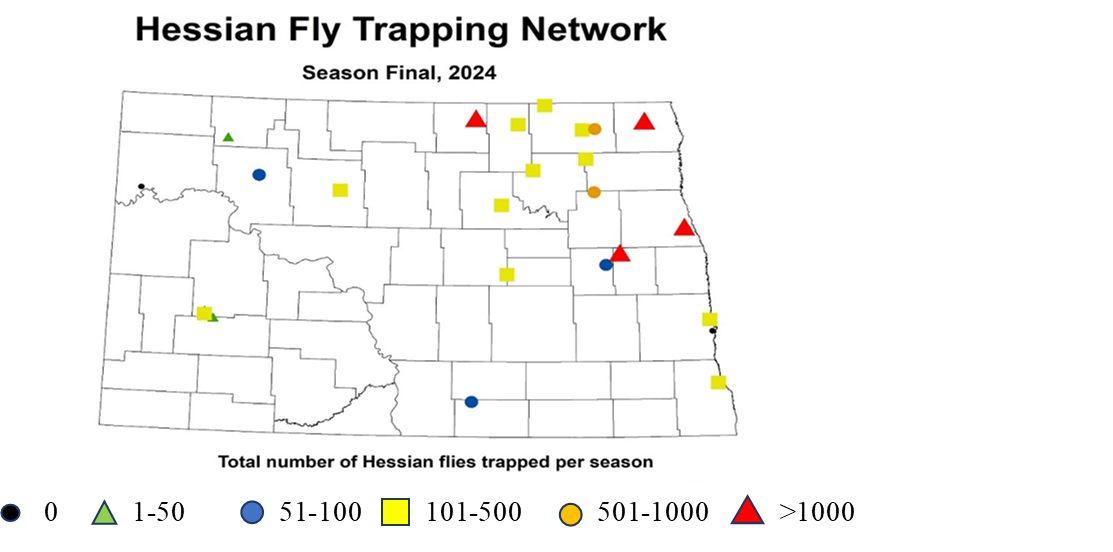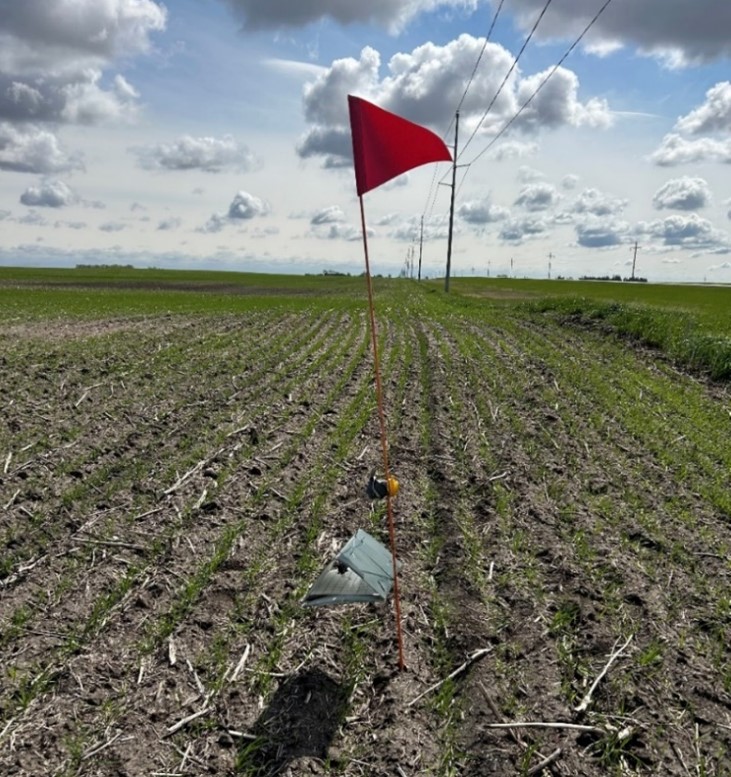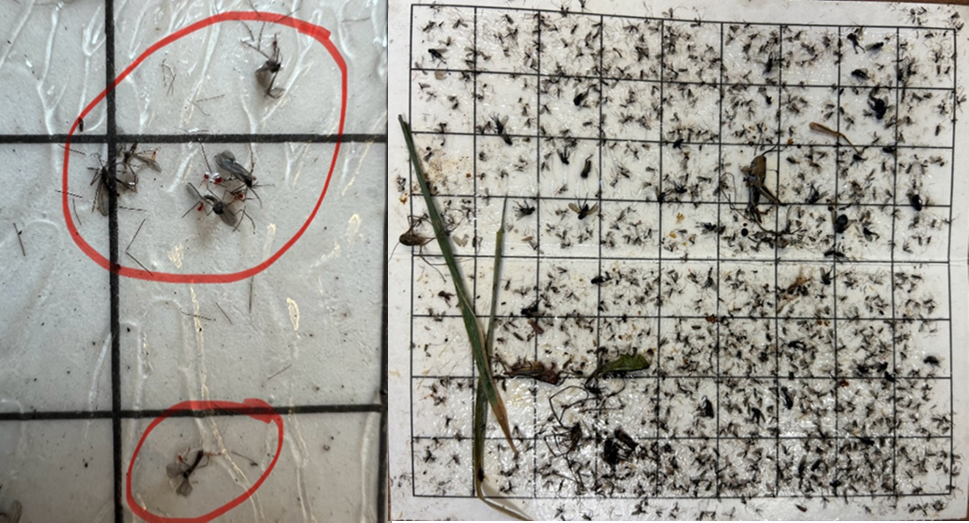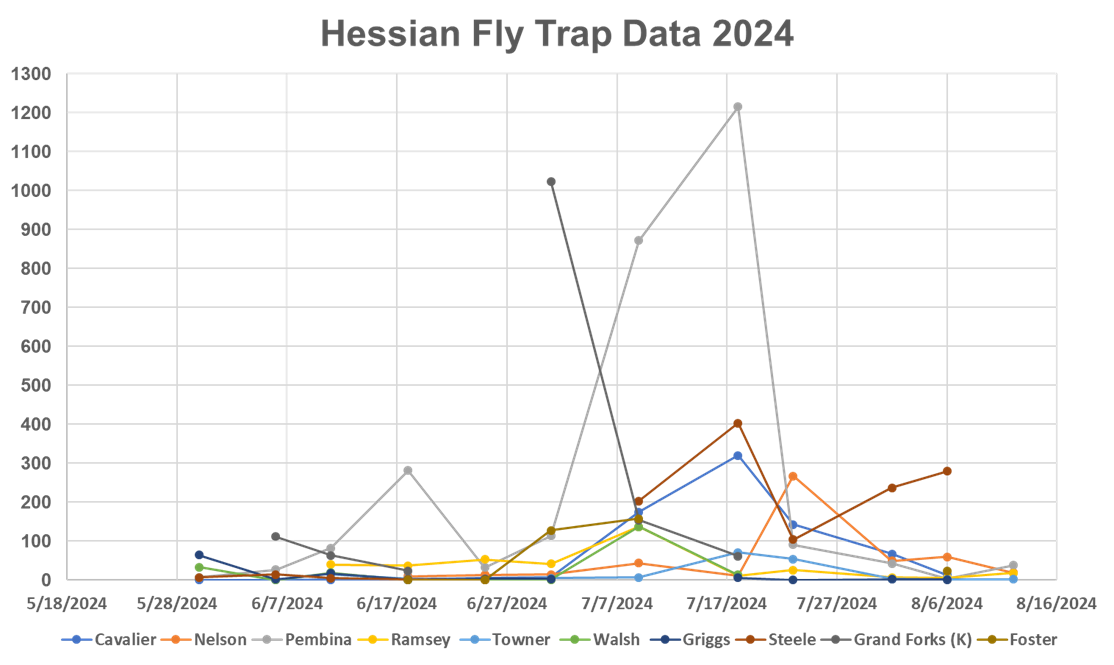2024: Hessian Fly Pheromone Trapping Report
(Research Report, Langdon REC, December 2024)Patrick Beauzay, Janet Knodel
Contributors:
Katelyn Landeis- Extension Agent, Grand Forks County
Megan Vig- Extension Agent, Steele County
Scott Knoke- Extension Agent, Benson County
Jeff Stachler- Extension Cropping Systems Specialist, Carrington Research Extension Center
Victor Gomes- Extension Cropping Systems Specialist, Dickinson Research Extension Center
Charlemagne Lim- Extension Weed Specialist, Williston Research Extension Center
Introduction:
Hessian fly, Mayetiola destructor (Say), is one of the most significant insect pests affecting wheat in ND. This insect pest was introduced into North America during the late 1770s in Long Island, New York by straw-bedding of Hessian soldiers during the American Revolution. Its populations have spread across the wheat-growing regions of the country. While wheat is the main preferable host, it also infests barley, rye and several species of grass as alternative hosts. Historically, Hessian fly has been a sporadic pest in ND, with notable outbreaks occurring in 1991, 2003 and 2015 (Knodel, 2015). A study conducted by Anderson et al. in 2012 utilized pheromone traps to monitor the distribution and spread of this insect in ND. However, this study is now a decade old, and in recent years we have seen an increase in Hessian fly outbreaks particularly in the northeast region of the state. To enhance our understanding of Hessian fly population distribution and peak emergence periods, a state-wide trapping program was initiated in ND using sex pheromone-baited sticky traps (Fig. 1).

Figure 1: Season count of 2024 Hessian fly trapping network
Materials and Methods:
Sex pheromone lures were obtained from Pherobank, Netherlands. These lures were deployed in delta sticky traps positioned on poles at the edges of the wheat fields (Fig. 2). Trap liners were changed weekly and stored in Ziploc bags in the freezer until the number of flies could be counted (Fig. 3). The lures were replaced every four weeks. Traps were established at the beginning of the season, immediately following wheat emergence, and remained in place until harvest. Monitoring dates varied by trapping sites. A total of 26 traps were placed in 21 counties.

Figure 2: Hessian fly pheromone trap set in a wheat field. Photo: Anitha Chirumamilla.

Figure 3: Pheromone trap sticky bottom with Hessian flies. Photo: Anitha Chirumamilla.
Results:
Distribution: Trapping results indicate a significant presence of Hessian fly across the state. In 2024, a total of 12,530 Hessian flies were captured on sticky traps monitored by IPM insect trappers from June to mid-August (Fig. 1 and Table 1). This marked a dramatic eight-fold increase compared to 2023, where only 1,527 Hessian flies were captured at 37 trapping sites.
The highest trap catches were found in the northeast and east central regions of North Dakota, where over 1,000 total Hessian flies per trap per season were reported in Pembina, Rolette, Grand Forks, and Steele counties, accounting for 4 of the 26 trap sites (about 15%). Additionally, 2 of the trap sites (approximately 7%) located in Cavalier and Nelson counties reported captures between 501 and 1,000 Hessian flies per trap per season. Eleven of the sites (around 42%) had captures ranging from 101 to 500 Hessian flies per trap per season, indicating a considerable presence of Hessian flies overall. Conversely, 8 of the sites (about 31%) recorded lower captures, ranging from 1 to 100 flies per trap per season, while only 2 sites (or 8%) in Williams and Cass counties had no Hessian flies (Table 1).
Table 1. Summary of Hessian fly trapping in North Dakota, 2024 | |
County | Total No. of Hessian Fly |
Dunn 2 | 0 |
Williams | 0 |
Cass 1 | 1 |
Stark | 3 |
Burke | 37 |
McIntosh | 51 |
Mountrail | 63 |
Griggs | 100 |
Benson | 112 |
Grand Forks | 155 |
Dunn 1 | 156 |
Cavalier-Hannah | 164 |
Cavalier-LREC | 169 |
Ward | 183 |
Richland | 231 |
Cass 2 | 252 |
Towner | 278 |
Walsh | 300 |
Foster | 310 |
Ramsey | 410 |
Nelson | 764 |
Cavalier | 777 |
Steele | 1254 |
Grand Forks (K) | 1552 |
Rolette | 2403 |
Pembina | 2805 |
Total | 12530 |
Peak Emergence:
Hessian fly is reported to have two generations in ND, with first-generation flies emerging in early spring and the second-generation flies appearing in late summer, specifically in August and September (Anderson et al., 2012). To understand these emergence patterns, we analyzed data from northeast counties of ND, focusing on weekly fly counts during the trapping period (Fig.4).
The graph representing weekly counts indicates that first generation Hessian flies emerged from their overwintering pre-pupal stage in spring coinciding with the emergence of spring wheat. Overall, population numbers initially appeared low across all trapping sites. Notably, there was no clear distinction between first- and second-generation flies, as emergence occurred throughout the season. However, the highest trap catches were observed in several counties (Pembina, Rolette, Cavalier, Steele, Grand Forks, Nelson and Walsh) during early to mid-July. Given the time interval between the first trap catches, these peaks can likely be attributed to the second generation (Fig. 4).

Figure 4: Weekly trap catch data of Hessian flies in northeastern counties of ND
Best Practices for Managing Hessian Fly Infestation
Pest management practices for control of Hessian fly should emphasize preventative management strategies to reduce reproduction and population levels rather than chemical control.
- Destroying Volunteer Wheat and Grass Hosts
- Eliminate any volunteer wheat and grassy hosts at least two weeks before planting to reduce potential pest habitat through herbicides or tillage.
- Selecting Non-Host Cover Crops
- Choose cover crops that do not host Hessian fly to disrupt their life cycle. While oats are not preferred hosts, rye is favored for oviposition and larval development.
- Time of Planting for Winter Wheat
Plant winter wheat, rye and barley cover crops after the “Hessian fly free planting dates”:
- Northern ND: After September 15
- Southern ND: After September 30
This timing helps to break the continuity of the pest life cycle. As flies emerge in late summer, there is no place for them to lay eggs. However, with the warmer and extended fall season that we are experiencing in North Dakota, the current fly free planting dates may become less effective due to the extended emergence of flies in the fall.
- Utilizing Resistant/Tolerant Varieties
- Planting resistant/tolerant varieties is the most cost-effective strategy for minimizing Hessian fly infestations and damage. Currently, no known resistance genes exist in varieties grown in ND. However, the spring wheat breeding program at NDSU is actively testing varieties with potential Hessian fly resistance genes, providing promising prospects for ND growers.
Chemical Control
Insecticide control of Hessian fly is difficult due to their long fly emergence window, lack of a monitoring protocol and a threshold, and environmental factors impacting fly emergence and activity. Chemical control of Hessian fly was researched in winter wheat but there is no information available regarding Hessian fly control in spring wheat.
- Insecticide seed treatments like thiamethoxam and imidacloprid can be used at the highest labeled rates in winter wheat. Insecticide residual is only effective for about 20 - 30 days after seeding, and Hessian fly may infest wheat well beyond that time. However, they provide little to no protection from spring infestations (Wilde et al. 2001).
- Research in winter wheat indicates that applying a pyrethroid insecticide during the 2-3 leaf stage of wheat can be effective against Hessian flies, if the insecticide application and peak fly emergence coincide (Flanders et al. 2013).
Historically, insecticides were not recommended in ND due to low Hessian fly populations. However, our 2024 trapping data revealed high numbers in the northeastern and east central areas of ND, with over 1,000 flies per trap per season, indicating a HIGH risk for Hessian fly infestation in wheat in 2025.
Acknowledgements
Thanks to the North Dakota Wheat Commission, the USDA NIFA CPPM EIP grant award 2021-70006-35330, and the North Dakota Department of Agriculture CAPS Program for support. Thanks to all the IPM trappers who helped us in 2023 and 2024.
References
Anderson, K. M., Y. Hillbur, J. Reber, B. Hanson, R. O. Ashley, and M. O. Harris. 2012. Using sex pheromone trapping to explore threats to wheat from Hessian fly (Diptera: Cecidomyiidae) in the Upper Great Plains. Journal of Economic Entomology, 105: 1988–1997.
Knodel, J. 2015. Hessian fly damaged wheat. North Dakota State University Crop and Pest, Report no. 15, August 13, 2015, Fargo, ND.
Flanders, K. L., D. D. Reisig, G.D Buntin, D. A. Herbert, Jr., and W. Johnson. 2013. Biology and management of Hessian fly in the Southeast. Alabama Cooperative Extension System: ANR1069.
Wilde, G. E., R. J. Whitworth, M. Claassen, and R. A. Shufran. 2001. Seed treatment for control of wheat insects and its effect on yield. Journal of Agricultural Urban Entomology. 18: 1-11.
